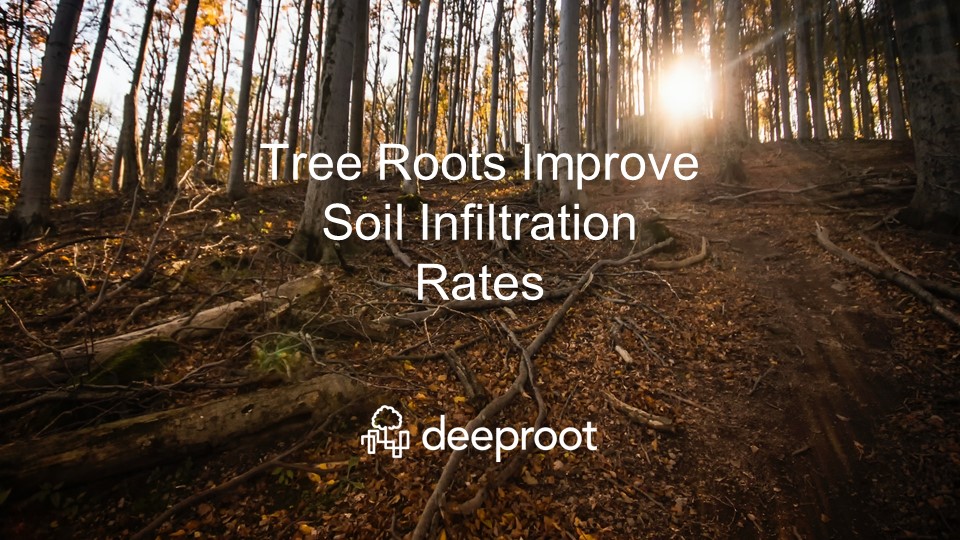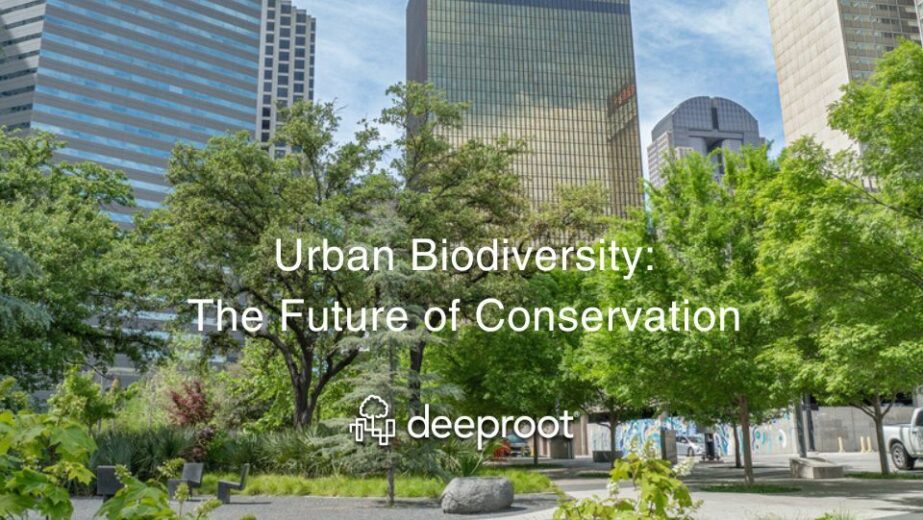As discussed in previous blogs, tree and soil provide stormwater benefits in many different ways:
- Cleansing: Trees clean stormwater through many different mechanisms, including filtration, adsorption, and plant uptake.
- Interception: Interception is the amount of rainfall temporarily held on tree leaves and stem surfaces. This rain then drips from leaf surfaces and flows down the stem surface to the ground, or evaporates.
- Infiltration: Infiltration is the movement of surface water into the soil, where it can be temporarily stored, infiltrated into the underlying soil, discharged to an underdrain, evaporated back into the atmosphere, or taken up by plants.
- Transpiration: Transpiration is a process in which plants absorb water through their roots and transfer it up to the leaves, where it evaporates into the environment through leaf pore transpiration. Transpiration continues to reduce stormwater volume stored in the soil long after a rainfall event ends.
Many of these mechanisms rely on adequate infiltration rates in order to function properly, so today I want to discuss the effects of trees on soil infiltration rates in more detail. Since clogged soil negatively affects the other mechanisms through which trees provide stormwater benefits, maintaining adequate infiltration in Stormwater Control Measures (SCMs) is crucial. Without adequate infiltration rates, for example, less water enters the soil, so less can be cleansed by the soil, soil microbes, and roots, and less water is available in the soil for transpiration.
Many studies have found that trees significantly increase soil infiltration rates. For example:
- Several studies of infiltration rates before and after deforestation or forest fires found decreased infiltration rates after the trees were gone (e.g. Wondzell and King 2003 in Herrera 2008).
- Gonzalez-Sosa et al (2010) found higher saturated hydraulic conductivity in areas of broadleaved forests and small woods than in permanent pasture soil and cultivated lands.
- Skorobogatov et al (2013) compared saturated hydraulic conductivity in woody vegetation plantings such as shelterbelts, tree groupings in urban parks, and tree rows in golf courses, with similar soil and topography, to the surrounding areas without trees, and found that trees had a significantly greater impact on soil permeability compared to lawn without trees.
- Chandler and Chappell (2008) found that median and mean saturated hydraulic conductivity 3 m from the trunks of individual oak trees were a factor of 2.3 and 3.4, respectively, larger than those of the surrounding grassland without trees. Their literature review also cites 12 other studies in which the ratio of saturated hydraulic conductivity of the A soil horizon under trees to that under adjacent pasture ranges from 2 to 140.
How trees increase infiltration rates
So how do trees influence soil infiltration rates?
Living and decaying roots create a network of well-connected channels in the soil called macropores. Flow-through these macropores can be up to several hundred times faster than flow through the soil matrix (Aubertin 1971 and Buttle and House 1997 in Chandler and Chappell 2008). In addition, organic matter from leaf litter and tree roots improves soil structure, which can increase infiltration rates. Soil structure is improved as soil particles are cemented together by humus, by organic glues created by fungi and bacteria decomposing organic matter, and by polymers and sugars excreted from roots.
Areas with trees generally have greater infiltration rates than lawn or pasture without trees because trees create more stable macropores. They do this for several reasons. The roots of dicotyledonous plants, like most trees, grow in thickness (secondary growth) as well as in length (primary growth). The roots of monocotyledonous plants, which include grasses, usually do not exhibit secondary growth, so their macropores are more prone to collapsing than the thicker macropores created by dicots. Also, woody plant roots have a lining on their roots that further increase the stability of the macropores after the root decays.
Impact of trees on infiltration rates in bioretention
Not surprisingly, several studies have documented that vegetation maintains adequate saturated hydraulic conductivity over time in bioretention areas (e.g. Lucas and Greenway 2011, Hatt et al 2009). Breen and Denman specifically compared unsaturated infiltration rates of model soil profiles in above-ground containers with trees to containers without trees and found that those with trees had higher infiltration rates. This tells us that even at a very young age, the trees were already having a positive effect on the hydraulic conductivity. Bartens et al (2009) also found that tree roots affected soil hydraulic conductivity even at a young age, and concluded that “woody roots can increase infiltration relatively quickly before there is opportunity for very large diameter roots to form and when root turnover is likely minimal…” and that therefore “it seems probable that water traveled around root channels along existing live roots.”
Conclusion
Trees and soils, also known as green infrastructure, can be extremely effective stormwater control measures. Since clogged soil negatively affects the other mechanisms through which trees provide stormwater benefits, maintaining adequate infiltration is crucial. Trees can help. Many studies demonstrate that trees and their roots have a positive impact on soil structure, creating stable micropores to maintain adequate infiltration rates that keep these systems functioning well.
References
Aubertin, G.M. 1971. Nature and Extent of Macropores in Forest Soils and their Influence on Subsurface Water Movement . U.S.D.A. Forest Service Research Paper NE-192 1971 Northeastern Forest Experiment Station, Upper Darby, Pa. Forest Service, U. S. Department Of Agriculture.
Bartens et al. Can Urban Tree Roots Improve Infiltration through Compacted Subsoils for Stormwater Management? Journal of Environmental Quality, 2008; 37 (6): 2048.
Hatt, Belinda E. Tim D. Fletcher, Ana Deletic. 2009. Hydrologic and pollutant removal performance of stormwater biofiltration systems at the field scale. Journal of Hydrology. 365 (3–4):310–321.Herrera Environmental Consultants, Inc. 2008. The Effects Of Trees On Stormwater Runoff. Prepared for. Seattle Public Utilities.
Buttle, J.M., D.A. House. 1997. Spatial variability of saturated hydraulic conductivity in shallow macroporous soils in a forested basin. Journal of Hydrology. 203(1–4) 127–142.
Kathy R. Chandler, Nick A. Chappell. 2008. Influence of individual oak (Quercus robur) trees on saturated hydraulic conductivity. Forest Ecology and Management. Volume 256, Issue 5, 20 August 2008, Pages 1222–1229.
Lucas, W. C. and M. Greenway. 2011a. Hydraulic Response and Nitrogen Retention in Bioretention Mesocosms with Regulated Outlets: Part I—Hydraulic Response. Water Environment Research 83(8): 692-702.
Skorobogatov, Anton. Wendy Thorne, and Bernard Amell. 2013. Biological Elements in Rain Garden Design. Presentation given at 2013 International Low Impact Development Symposium, August 18-21, 2013, Saint Paul, Minnesota.
Wondzell, S.M., and J.G. King. 2003. Post fireErosional Processes in the Pacific Northwest and Rocky Mountain Regions. Forest Ecology and Management 178(1-2):75-87.
Nathalie Shanstrom is a sustainable landscape architect with The Kestrel Design Group.
Photo: musicFactory lehmannsound from Pexels






I write a newsletter for my local arborist, community tree leaders, nurserymen, etc. I am requesting permission to republish the article with appropriate credits from: http://www.deeproot.com/blog/blog-entries/how-trees-affect-soil-infiltration-rates in my newsletter called “The Stump”. You can see past issues at: http://thestumpnewsletter.weebly.com to determine how I reach my audience and if it is acceptable to you.
Thanks
You are welcome to reprint the article! Please credit the author (Nathalie Shanstrom) and the publisher (DeepRoot Green Infrastructure, LLC).
Thanks for the article. I have been somewhat informally studying the impact of both trees and prairie plants on infiltration rates for several years and trying to determine if there is a way to quantify their effect. I have two articles in Stormwater Magazine to reference if you’re interested. I am currently working on a journal article that goes one step further. The articles can be found here: http://www.stormh2o.com/SW/Articles/15715.aspx
and here: http://www.stormh2o.com/SW/Editorial/Quantifying_Prairie_and_Forest_Impacts_on_Soil_Wat_15583.aspx
Cheers,
Scott
Thanks, Scott! We’ll definitely check out your articles.
Scott, Where will your new article be published? I’d love to read it when its available! Also thanks for the links to your Stormwater Magazine articles!